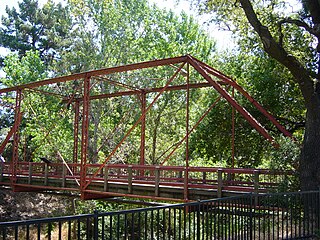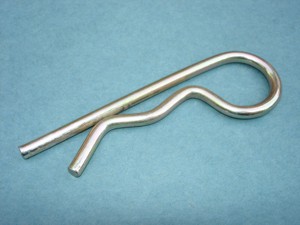
A shackle, also known as a gyve, is a U-shaped piece of metal secured with a clevis pin or bolt across the opening, or a hinged metal loop secured with a quick-release locking pin mechanism. The term also applies to handcuffs and other similarly conceived restraint devices that function in a similar manner. Shackles are the primary connecting link in all manner of rigging systems, from boats and ships to industrial crane rigging, as they allow different rigging subsets to be connected or disconnected quickly. A shackle is also the similarly shaped piece of metal used with a locking mechanism in padlocks. A carabiner is a type of shackle used in mountaineering.
A pin is a device used for fastening objects or material together.

Roller chain or bush roller chain is the type of chain drive most commonly used for transmission of mechanical power on many kinds of domestic, industrial and agricultural machinery, including conveyors, wire- and tube-drawing machines, printing presses, cars, motorcycles, and bicycles. It consists of a series of short cylindrical rollers held together by side links. It is driven by a toothed wheel called a sprocket. It is a simple, reliable, and efficient means of power transmission.

A banana connector is a single-wire electrical connector used for joining wires to equipment. The term 4 mm connector is also used, especially in Europe, although not all banana connectors will mate with 4 mm parts, and 2 mm banana connectors exist. Various styles of banana plug contacts exist, all based on the concept of spring metal applying outward force into the unsprung cylindrical jack to produce a snug fit with good electrical conductivity. Common types include: a solid pin split lengthwise and splayed slightly, a tip of four leaf springs, a cylinder with a single leaf spring on one side, a bundle of stiff wire, a central pin surrounded by a multiple-slit cylinder with a central bulge, or simple sheet spring metal rolled into a nearly complete cylinder. The plugs are frequently used to terminate patch cords for electronic test equipment such as laboratory power supply units, while sheathed banana plugs are common on multimeter probe leads.

A fastener or fastening is a hardware device that mechanically joins or affixes two or more objects together. In general, fasteners are used to create non-permanent joints; that is, joints that can be removed or dismantled without damaging the joining components. Steel fasteners are usually made of stainless steel, carbon steel, or alloy steel.

A clevis fastener is a two-piece fastener system consisting of a clevis and a clevis pin head. The clevis is a U-shaped piece that has holes at the end of the prongs to accept the clevis pin. The clevis pin is similar to a bolt, but is either partially threaded or unthreaded with a cross-hole for a split pin. A tang is a piece that is sometimes fitted in the space within the clevis and is held in place by the clevis pin. The combination of a simple clevis fitted with a pin is commonly called a shackle, although a clevis and pin is only one of the many forms a shackle may take.

A linchpin, also spelled linch pin, lynchpin, or lynch pin, is a fastener used to prevent a wheel or other part from sliding off the axle upon which it is riding. The word is first attested in the late fourteenth century and derives from Middle English elements meaning "axletree pin".

A pin is a device, typically pointed, used for fastening objects or fabrics together. Pins can have the following sorts of body:

A split pin, also known in the US as a cotter pin or cotter key, is a metal fastener with two tines that are bent during installation, similar to a staple or rivet. Typically made of thick wire with a half-circular cross section, split pins come in multiple sizes and types.

A bobby pin is a type of hairpin, usually of metal or plastic, used in coiffure to hold hair in place. It is a small double-pronged hair pin or clip that slides into hair with the prongs open and then the flexible prongs close over the hair to hold it in place. They are typically plain and unobtrusively colored, but some are elaborately decorated or jeweled. Bobby pins became popular in the 1920s to hold the new bobbed hairstyles.

In structural engineering and construction, an eyebar is a straight bar, usually of metal, with a hole ("eye") at each end for fixing to other components. Eyebars are used in structures such as bridges, in settings in which only tension, and never compression, is applied. Also referred to as "pin- and eyebar construction" in instances where pins are being used.

A shear pin is a mechanical detail designed to allow a specific outcome to occur once a predetermined force is applied. It can either function as a safeguard designed to break to protect other parts, or as a conditional operator that will not allow a mechanical device to operate until the correct force is applied.
Billiard or billiards may refer to:

A cotter is a pin or wedge passing through a hole to fix parts tightly together. In British usage cotter pin has the same meaning, but in the U.S. it means a split pin.

A screw and a bolt are similar types of fastener typically made of metal and characterized by a helical ridge, called a male thread.

An R-clip, also known as an R-pin, R-key, hairpin cotter pin, hairpin cotter, bridge pin, hitch pin clip or spring cotter pin, is a fastener made of a durable but flexible material, commonly hardened metal wire, resembling the shape of the letter "R".

A watch strap, watch band,watch bracelet or watch belt is a bracelet that straps a wrist watch onto the wrist. Watch straps may be made of leather, plastic, rubber, cloth, or metal, sometimes in combination. It can be regarded as a fashion item, serving both a utilitarian and decorative function. Some metal watch straps may be plated with, or even in rare cases made of, precious metals.













